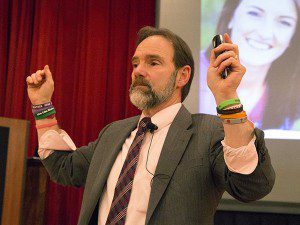Acts of Love: What Color Wristband Would You Wear?
Joel’s Story:
I remember sending pink roses to my daughter Casey for Valentine’s Day. Pink was her favorite color.
Casey was killed by a distracted driver. She was 21. After Casey was killed I feared that she would be forgotten-she would not graduate college, find a career, marry, have children and continue to make a difference in the world. I became an advocate for distraction-free driving and now devote most of my time to those efforts. I tell my daughter’s story to keep her memory alive and so that her life and death will save other lives. I am and will always be a grieving parent- I live and my child is dead; I have a future and my child does not; I try to make sense of how and why my child died but cannot.
I wear a pink wristband to remember my daughter. But I am not alone in wearing a wristband to remember my dead child. Many other parents wear wristbands to remember their children killed by distracted driving. We exchange wristbands to remember each other’s children and I wear wristbands given to me by other grieving parents. On my right wrist are those for the girls-lavender for Katie, Green for Toni and R.J., purple for Heather and orange for Chloe. On my left wrist are the boys- lime-green for Conor, blue and white for Paul, gray for Reece, black for Connor and orange for Owen- grieving parents, struggling to make sense of something that defies explanation, wearing wristbands in our dead children’s favorite colors.
Motor vehicle crashes are the leading cause of death for U.S. teens. Seven teens ages 16 to 19 die every day from motor vehicle injuries. Teen drivers ages 16 to 19 are nearly three times more likely than their elders to be in a fatal crash.
Teen motor vehicle crashes are preventable, and proven strategies can improve the safety of young drivers on the road. One of those strategies is to prohibit the use of portable electronic devices while driving.
In 2002, the NTSB issued its first recommendation related to cell phone distraction following the investigation of a crash involving a novice driver who was distracted by a cell phone conversation with a friend. She veered off the roadway in Largo, Maryland, crossed the median and flipped the car on top of another vehicle. That phone call cost not only her life, but also the lives of four others.
Since then, the NTSB has joined advocates like Joel and so many others to carry the message of the need to disconnect from deadly distractions across the Nation.
Today, NTSB Safety Advocacy Nicholas Worrell had the opportunity to join Joel at the American Association for Justice to speak with lawyers, professionals, parents, and students concerning the dangers of distracted driving.
The responsibility for the development of safe driving behaviors isn’t solely on our teens. Studies show that teens are influenced by and listen to their parents. In fact, teens whose parents drive distracted are 2-3 times more likely to also drive distracted. Children really do listen to what we say. But more importantly, they watch what we do.
Joel’s message to parents is simple, “Be the driver you want your child to be.”
He challenges each of us to answer the question,
“What driving distractions would you give up if it meant saving your child’s life?” http://youtu.be/7blscraKHDs
______________________
Joel Feldman’s daughter Casey was killed by a distracted driver in 2009. After her death he founded EndDD.org.






